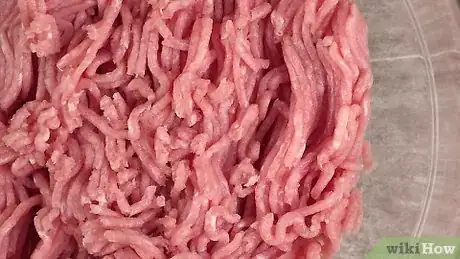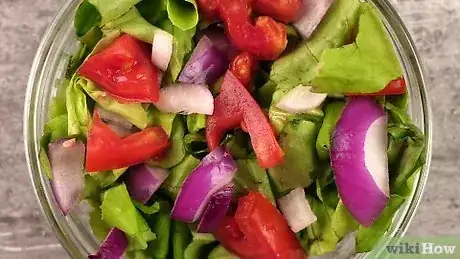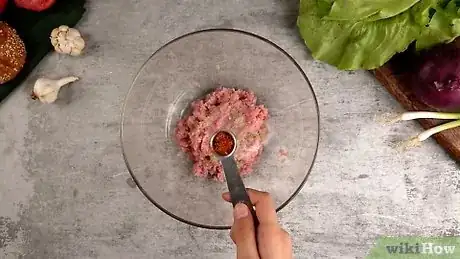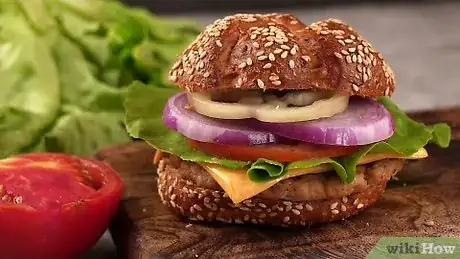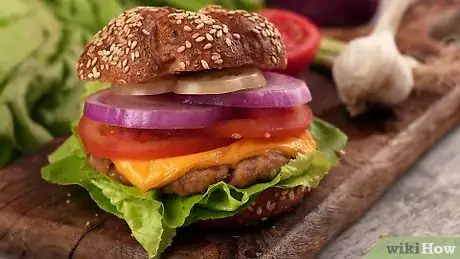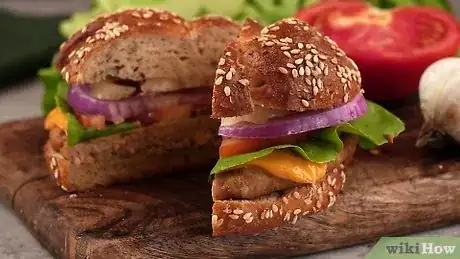This article was co-authored by Courtney Fose, RD, MS. Courtney Fose is a Registered Dietitian and Certified Nutrition Support Clinician at the University of Arkansas for Medical Sciences. She has worked as a Dietitian since 2009, and received her MS in Clinical Nutrition from the University of Arkansas in 2016.
There are 22 references cited in this article, which can be found at the bottom of the page.
This article has been viewed 16,518 times.
Hamburgers are one of the most popular food options, especially in the summertime. But if you're trying to eat healthy, cut fat and cholesterol, or lose weight, eating a hamburger might seem impossible. You don't have to give up hamburgers if you are trying to live a healthier lifestyle. If you learn how to make smarter choices, you can eat flavorful burgers and stay healthy.
Steps
Making a Healthier Beef Hamburger
-
1Choose lean ground beef. Lean ground beef has less than 10 grams of fat, 4.5 grams or less of saturated fat, and under 95 milligrams of cholesterol for a cooked three-ounce patty. Extra lean ground beef has less than five grams of fat and less than two of saturated fat.[1]
- Lean beef is labeled as 90/10 or 10%, and extra lean is labeled as 95/5 or 5%
- Beef contains all the essential amino acids needed for growth and maintenance of our bodies. Eating high-quality protein is useful for maintaining muscle mass and recovery after trauma or surgery. Beef contains an abundant amount of vitamins and minerals, including Vitamin B12, Zinc, Selenium, Iron, Niacin, Vitamin B6, and Phosphorus.
-
2Look for grass-fed beef. Choosing grass-fed beef will increase the antioxidant content, Vitamin E levels, a healthier fatty acid profile including more omega-3 fatty acids compared to grain-fed beef. Grass-fed beef means the cattle were, as the name suggests, fed mostly grass and other foods that they would naturally eat in their environment. Grain-fed cattle mostly eat an unnatural, grain-based diet.[2]Advertisement
-
3Make smaller patties. Serving size is important when you make your hamburger. Some hamburgers can be 6, 8, or even 16 ounces. No one needs a hamburger that large. You can enjoy a hamburger, but on a smaller, healthier scale. This saves you calories, fat, and cholesterol. When you make a hamburger, make your patties 3 to 4 ounces when raw.[3]
-
4Consider cooking the hamburger on the grill. Grilled hamburgers have a great flavor, and grilling hamburgers can also help make the hamburger healthier. When you grill a burger, some of the fat drips out during the process. The hamburger can end up having less fat than you originally thought.[4]
- You can also cook burgers on griddle pans and the broiler.
-
5Maximize the flavor of leaner beef. Since leaner ground beef has less fat content, it can be harder to cook, but you can still cook a delicious burger if you know how to cook these meats. For 90/10 beef, cook over medium heat. Cook on one side until the side is brown, then flip and cook the other side until brown. It usually takes 11 to 15 minutes to cook the burger. Just make sure to cook until the patty is done.
- Coat the pan with cooking spray. This helps to keep the patties from sticking when you cook them. Heat the pan before you place the patty in the pan.
- The USDA has a rating scale of Prime, Choice, and Select for beef. The leanest of these will be Select, which will have less marbling (meaning there is less fat interspersed with lean meat).
- To help keep them juicy, avoid piercing the patties or pressing down on them in the pan.
-
6Season the burgers to add flavor. If you find the lean meat lacking in flavor or juiciness, try adding seasonings and extras to the patties to add flavor without adding calories and fat. Season with salt, pepper, seasoning salt, paprika, dried herbs, barbeque sauce, steak sauce, and garlic salt.[5] [6]
- Try mixing an egg white in with the patty. You can also add a ¼ cup of wheat bread crumbs. Or instead of bread crumbs, try a gluten-free option with almonds, walnuts, or other nuts.[7]
- Add things you'd traditionally place on top of the burger inside the patty. Mix in onions, tomatoes, spinach, mushrooms, salsas, or any other vegetables to make a tasty burger. Even try adding a small amount of low-fat cheese.
-
7Blot the excess fat. After you cook the patties, remove them from the pan and place them on a paper towel. Use another paper towel to gently soak up the fat on the patty. This helps reduce the calories and fat.[8]
Using Alternatives to Ground Beef in Burgers
-
1Make a turkey burger. A popular alternative to beef hamburgers are turkey burgers. Though many people believe turkey burgers contain less fat and calories than beef burgers, this is not always true. Ground turkey can have a higher fat content than a traditional hamburger. When buying ground turkey, make sure that you buy a lean cut. Look for packages that are 90/10 or higher, such as 93/7 or 99.
- To make turkey burgers delicious and juicy, try adding olive oil to the patty. Add two tablespoons of olive oil for each pound of ground turkey. This also helps give them a brown crust on the outside.[9] Remember, however, that adding olive oil will add (healthy) fat and calories to your burger.
- Try chicken burgers for another poultry burger. Just place cooked chicken breast in a food processor with any seasonings or additional ingredients. Then shape into patties.[10]
-
2Try a bison burger. Bison can be a healthy alternative to traditional ground beef in burgers. Bison is a leaner meat than ground beef. In a three and a half ounce serving, bison ranges from two to nine grams of fat and 143 to 190 calories. In three and half ounces of ground bison, there might be 15 grams of fat and 240 calories.[11]
- Bison has good amounts of protein, iron, zinc, and B12. It also a good source of omega-3 fats.
- Bison can be temperamental to cook. It doesn't take long to cook, and is tough if overcooked. Ground bison should be cooked until the pink just starts to disappear.
-
3Choose fish. Fish makes a great substitute for beef in burgers. Tuna, salmon, and tilapia all make tasty burgers. Fish burgers generally need additional herbs and spices to give them a tasty flavor. Try soy sauce, ginger, cilantro, scallions, garlic, or olive oil. Fish typically has less calories than beef, and is a great source of omega-3 fats.[12]
- To make the fish filets into burger patties, cut the filets into small cubes. Combine the cubes with the other ingredients in a bowl, mixing gently with your hands until everything is combined. Press the mixture into patties that are about four inches thick. You can cover the outside with sesame seeds, bread crumbs, or nuts.
- Another way to make a fish burger is to place the fish and other ingredients into a food processor until it's combined.[13]
-
4Make meatless burgers. If you redefine your idea of a hamburger, you will have endless choices for the meat. Meatless burgers are a popular and versatile way of making burgers. Not only can you buy healthy veggie and bean burgers, but you can make your own out of just about any hearty vegetable.[14]
- Try making a veggie burger from chickpeas, black beans, white beans, lentils, quinoa, tofu, beets, or sweet potatoes. To make them into a burger, just mash them together, add in spices, and then form into patties.
- You can use whole portobello mushrooms or slices of eggplant in place of meat for heartier burgers.
- Most veggie burgers cannot be cooked on the grill. They do well in pans or in a broiler.
Choosing Healthy Toppings For Your Burger
-
1Reduce your calories by changing your bun. White buns can add a lot of calories and unhealthy carbs to your burger. Instead of eating on a white bun, change to a whole wheat bread source. But don't grab the first wheat bun off the shelf. Take time to read the label.
- Don't buy breads with enriched bleached flour or wheat flour. Instead, choose a 100% whole wheat bread. Make sure it says 100% whole wheat. Look for the label to say whole-wheat flour as the first ingredient.[15]
- Choose to only eat one half of the bun, making it an open-faced sandwich. This cuts your calories by half.
- Substitute your regular bun for an English muffin.
- If you are eating at a get together, remove some of the bun insides to reduce calories.[16]
-
2Skip the bun. Another way to eat healthier hamburgers is to go carb-less and eat no bun. Choose to eat your burger on a lettuce wrap, a collard leaf, or a romaine wrap. You can also place the patty on a bed of kale, spring greens, or spinach.[17]
- Get creative with what you place your burger on. Try putting it between slices of grilled eggplant or zucchini.
-
3Switch out your condiments. Ketchup is full of sodium and sugar, and mayonnaise if full of fat. Instead of covering your burger with these things, try adding other kinds of toppings to your burger. Condiments are typically processed foods. Adding whole foods like avocado or an egg are ways to incorporate whole foods that do not include added preservatives or sodium. Once you switch from traditional condiments, you'll be surprised the array of flavors you've been missing on your burgers.
- Mash 1/3 of an avocado and spread it on your burger. Avocado is a superfood that is healthy and delicious (though it is high in calories, so don't use too much).[18] Add spices, fruit, vegetables, and herbs to the avocado for even more flavor.
- Make your own spreads. Combine Greek yogurt with garlic, and lemon juice for a tasty condiment. Or try making a pesto sauce.
- Try salsa on your burgers. This provides a lot of flavor without tons of fat, sugar, or calories.[19]
- Add hummus onto your burger. Hummus comes in many different varieties, from plain to lemon to red pepper. You can also try tabouli.
- Make a healthy slaw. Combine cabbage, greek yogurt, and other spices or herbs and pile it on your patty.
-
4Reconsider cheese. Cheese can add a lot of fat and calories to your burger. If you have to have cheese on your burger, consider slicing block cheese into thin slices. You can also purchase ultra thin varieties of cheese.[20] Choose low-fat cheeses and try to avoid highly processed cheeses like Velveeta.
- As alternatives to traditional cheese, try adding feta or goat cheese to your burger. Feta cheese has a lower fat, saturated fat, and calorie content than regular cheese.[21] Goat cheese has a few less calories and grams of fat than traditional cheese. For example, one ounce of goat cheese has 76 calories, 6 grams of fat, 4 grams of saturated fat, and 13 milligrams of cholesterol.[22] One ounce of cheddar cheese has 113 calories, 9 grams of fat, 6 grams of saturated fat, and 29 milligrams of cholesterol.[23]
-
5Pile on the vegetables and fruit. Another way you can make your burger extremely healthy is to pile it with more nutritiously dense food. Vegetables not only add nutrients, they also add flavor. Try roasted tomatoes, roasted peppers, sauteed mushrooms, or caramelized onions.[24]
- Top with any leafy greens, like arugula, spinach, or kale. Put bell pepper, cucumbers, carrots, sprouts, and alfalfa.
- Put fruit on your burger. Try grilled pineapple, mango, or persimmons.
- Avoid topping that will add unhealthy fats, like bacon.
-
6Make smart choices when adding sides. Sometimes, it's not the burger that's unhealthy; it's the sides. A small order of fries from McDonald's has 230 calories, 11 grams of fat, and 1 1/2 grams of saturated fat. A large order of fries has 510 calories, 24 grams of fat, and 3 1/2 grams of saturated fat.[25] Even French fries that you cook at home have a lot of calories. Instead of eating an unhealthy side, add a salad or a serving of fruit.[26]
- Take care to pay attention to what you drink, too. Instead of a sugary soda, choose water, seltzer water, or a diet soda.
Making Smart Choices When Dining Out
-
1Choose the best hamburger. You can eat hamburgers when you go out to eat if you plan ahead and choose conscientiously. Think of ways to reduce unnecessary calories, fat, and cholesterol. For example, remove the bun or ask for the burger on a bed of lettuce. [27]
- Ask for no mayo or for the condiments on the side, plus no cheese or bacon. This cuts out a lot of unhealthy additions to your burger.
-
2Eat smaller portions. One reason eating a hamburger out is such hit to your nutrition is the size of the serving you receive. Many burgers contain anywhere from 1/4 pound of meat to an entire pound. Some burgers have multiple patties of meat. Choose only hamburgers with one patty.[28]
- For restaurants that serve extremely large patties, share the burger with a friend, or cut the burger in half and save part for a later meal.
-
3Be an informed consumer. When you eat burgers at restaurants, do your research beforehand. Don't order without knowing the nutritional information of your meal. Many restaurants provide calories on menus now, so you can know exactly how many calories you are consuming. But you should also look online at nutritional information for additional information, like fat, saturated fat, and cholesterol.
- Know the calorie content of the burgers you are eating. For example, a Dave's Single from Wendy's has 550 calories, 34 grams of fat, and 13 grams of saturated fat.[29] At Five Guys, a hamburger has 700 calories, 43 grams of fat, and 19.5 grams of fat. At Applebee's, a hamburger has 780 calories, 50 grams of fat, and 18 grams of saturated fat while a mushroom swiss burger 1060 calories, 72 grams of fat, and 28 grams of saturated fat.
- Since you want to try to keep your meals under 500 calories, try these hamburgers instead. A jr. hamburger at Wendy's has 230 calories, 8 grams of fat, and 3 grams of saturated fat. In-and-Out as a “protein style” burger with no bun that has 240 calories, 17 grams of fat, and 4 grams saturated fat. A little hamburger at Five Guys has 480 calories, 26 grams of fat, and 11.5 grams of saturated fat.[30]
- These calorie and fat counts don't include fries, so stay away from those.
References
- ↑ http://www.webmd.com/food-recipes/build-better-burger?page=2
- ↑ https://authoritynutrition.com/grass-fed-vs-grain-fed-beef/
- ↑ http://www.eatingwell.com/article/104384/how-to-cut-400-calories-from-your-burger/
- ↑ http://www.webmd.com/food-recipes/build-better-burger
- ↑ http://www.health.com/health/gallery/0,,20388238_2,00.html
- ↑ http://www.webmd.com/food-recipes/build-better-burger?page=5
- ↑ http://greatist.com/health/healthy-burger-recipes
- ↑ http://www.webmd.com/food-recipes/build-better-burger?page=4
- ↑ http://www.cookinglight.com/cooking-101/techniques/cooking-questions-tips/how-to-avoid-dry-turkey-burgers
- ↑ http://www.cookinglight.com/food/recipe-finder/healthy-chicken-breast-recipes/chicken-burgers-recipes
- ↑ http://www.berkeleywellness.com/healthy-eating/food/article/bison-meat-better-beef
- ↑ http://www.health.com/health/recipe/0,,20918716,00.html
- ↑ http://culinaryginger.com/tilapia-burgers/
- ↑ http://www.cookinglight.com/food/vegetarian/veggie-burger-recipes
- ↑ http://www.webmd.com/food-recipes/the_best_bread_tips_for_buying_breads?page=2
- ↑ http://www.eatingwell.com/article/104384/how-to-cut-400-calories-from-your-burger/
- ↑ http://www.webmd.com/food-recipes/build-better-burger?page=4
- ↑ http://www.californiaavocado.com/nutrition/nutrients
- ↑ http://www.eatingwell.com/article/104384/how-to-cut-400-calories-from-your-burger/
- ↑ http://www.eatingwell.com/article/104384/how-to-cut-400-calories-from-your-burger/
- ↑ https://www.bhf.org.uk/heart-matters-magazine/nutrition/cheese
- ↑ http://www.caloriecount.com/calories-goat-soft-type-cheese-i1159
- ↑ http://nutritiondata.self.com/facts/dairy-and-egg-products/8/2
- ↑ http://www.webmd.com/food-recipes/build-better-burger?page=4
- ↑ http://nutrition.mcdonalds.com/getnutrition/nutritionfacts.pdf
- ↑ http://www.webmd.com/food-recipes/build-better-burger?page=4
- ↑ http://www.webmd.com/food-recipes/build-better-burger?page=4
- ↑ http://www.webmd.com/food-recipes/build-better-burger?page=4
- ↑ https://www.wendys.com/en-us/nutrition-info
- ↑ http://www.health.com/health/gallery/0,,20504336,00.html

